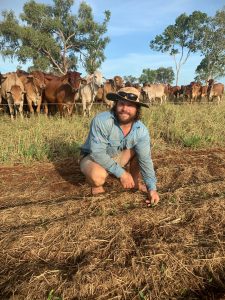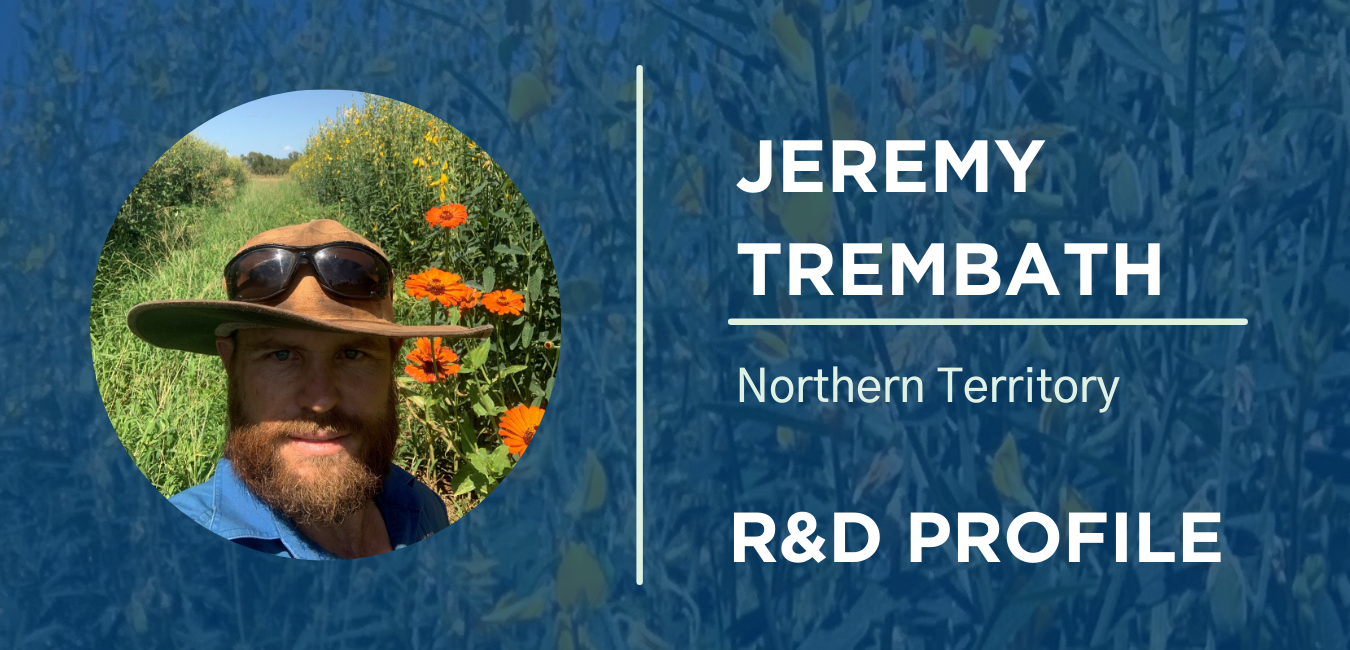Passion for soils leads to hosting Top End demonstration site
The Soil Wealth and Integrated Crop Protection project team has set its sights on the Northern Territory in 2021/22, working with Jeremy Trembath and his family to establish a trial site on his cattle and vegetable farm just north of Katherine. In this edition, Michelle De’Lisle speaks to Jeremy about his involvement in the project, the farm’s approach to soil health and what lies ahead.
Jeremy Trembath, along with his parents and wife Amy, operates an almost 1,000-hectare cattle farm five kilometres north of Katherine in the Northern Territory.

“We’ve been running a breeding herd of cattle for around 18 years and for a time we had pasture –annual and perennial – that we cut for hay for on- and off-farm use and sale,” Jeremy says.
“We had a 2,200 strong Kensington pride mango tree orchard. But when the industry became unviable for us as smaller scale growers, we removed the trees and put the area to perennial pasture.”
The Trembaths are focusing on what Jeremy describes as “little D (development) and big M (maintenance).” They have implemented a three-year pasture/one-year vegetables rotation system.
“It (the farm) is both the under- and above-ground honest and driven workforce that we need,” he says.
“Cattle, landscape regeneration and growing healthy vegetables is currently our focus. That said, we have come to recognise that to grow cattle and crops we grow grass and for that we need soil – plenty of good, healthy, stable soil. So not that we consider ourselves expert or experienced, we are, in fact, soil farmers.”
The soils are light textured with low organic matter levels and are prone to erosion, which is the biggest challenge on the farm. Additionally, wet/dry season cycles result in compaction of the soil top layer which requires tillage, although minimum tillage activity is the goal. Jeremy has sown seed directly into the soil without tillage in the past and that worked well.
On the farm, the aim is to move away from synthetic inputs and include more legumes as natural sources of nitrogen. This will benefit the small-scale horticulture that is planned for the winter months, including a harvest garden for local families hoping to access a broad range of fruit and vegetables.
Soil Wealth and Integrated Crop Protection: Becoming involved
In mid-2021, NT Farmers Director of Regions and Projects Simone Cameron (formerly the VegNET – Northern Territory Regional Development Officer) introduced the Trembaths to Soil Wealth and Integrated Crop Protection – Phase 2, which is a strategic levy investment under the Hort Innovation Vegetable Fund.
The Trembaths are currently hosting a demonstration site, with the Soil Wealth ICP project team assisting Jeremy with building greater resilience to heavy weather events and soil erosion. This is through growing a corn cash crop following mixed cover crops, reduced till (strip till), the input of soil biology (mycorrhizal inoculants) and early-stage non-chemical weed control with a finger weeder.
“We’re keen to be involved in anything that looks at soil health. The main benefit of being involved in the project is the knowledge and guidance that we have had access to and been given. It has been invaluable,” Jeremy says.

“We highly recommend this project to anyone interested. There is sound advice and support.”
Grower observations
It’s too early to say if there has been any yield improvement. At the time of writing, the Trembaths had just sown their first corn crop in the area, so any results won’t be seen until spring. It is hoped that the corn will prove an easy win for raising organic matter levels in the soil.
However, Jeremy has seen some positive changes. This is, he says, though the use of bio fertiliser, no kill, no till, strategic grazing – and a bit of love. These include:
- A reduction of undesirable species on-farm by at least 70 per cent.
- Taken an area with basal cover of around 10 per cent to more than 25 per cent.
- As a knock-on of an organic approach, there are sida beetles stripping sida plants (the Trembath’s most prolific ‘weed’) to bare stalks in places.
- Cattle pats are a moving mass of dung beetles.
- Patches of ground the size of a house that have been completely bald for years are now covered.
“We always were of the mind that we needed to remediate these sorts of areas with a recipe of deep ripping and gypsum application. While we still like the idea of those inputs, we’ve come to realize that in fact it is the microbiology in the soil that is the key. We call them our underground herd,” Jeremy says.
- In big (75mm+) rain events, there has been no runoff where before there would have been water movement and erosion.
- Earthworms have appeared in the paddock where the Trembaths have never seen them before.
“I recently took a soil sample to compare with last year’s pre-cover crop and cannot quantify an improvement, except for the pH moving closer to neutral from being slightly more acid than desirable. Also, digging is easier, and it certainly feels more alive,” Jeremy says.
“These regenerative practices have been used by farmers all over the world for the past 10,000 years. We are just really excited to discover that we don’t need to ‘farm out of a bag’ and can achieve great results without it.”
Jeremy added that trial has not necessitated any large changes in the Trembath’s farming system.
“Our on-farm revolution started before the trial, but the trial has worked in well with what we were looking to achieve. We would like to think that we are constantly changing and adapting as we find what works and what doesn’t,” he explains.
A sustainable future
Once the trial has concluded, the Trembath family will continue to explore farm fertility and ways to become less reliant on imported inputs.
“We are looking at how we can contribute to whole farm systems and grow vegetables for a longer season, so that as a community we can regain some lost sovereignty by locally having high-quality, nutrient dense food,” Jeremy says.
“The next project will be having a go at brewing our own nitrogen fixing organisms and how we keep them around over the hot and dry periods of the year. This will be coupled with sourcing and making our own fertiliser and soil conditioning products.
“Also, trying no-till corn. This year, we are lightly running a rotary hoe pre-planting, but I’d like to try sowing directly into a heavy cow pea crop.”
Acknowledgements
This article is based on a case study produced by the Soil Wealth ICP team, and can be found online here.
More Soil Wealth ICP case studies can be found online by clicking here.
Find out more
For more information about the Soil Wealth/ICP project, please contact project leaders Dr Gordon Rogers on 02 8627 1040 or gordon@ahr.com.au and Dr Anne-Maree Boland on 03 9882 2670 or anne-mareeb@rmcg.com.au.
This project has been funded by Hort Innovation using the vegetable and potato research and development levy and contributions from the Australian Government.
Project Number: VG16078

